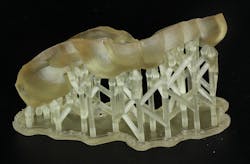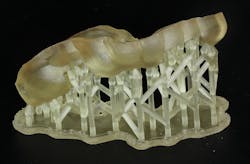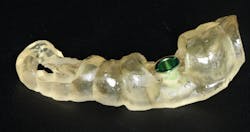2018—the year of 3-D printing in the dental office?
3-D printing allows dentists to fabricate appliances that are not possible any other way and to provide services faster and more profitably. Implant surgical guides and orthodontic aligners are just two examples.
Rick Ferguson, DMD, DABOI, DICOI
In the early days of dentistry, in-office fabrication of dental appliances was commonplace. Up until very recently, most dentists were trained in dental school in the fabrication of crowns, dentures, and even orthodontic appliances. However, as the materials and techniques evolved, the cost of in-office fabrication, both in terms of money and time, made it impractical for a clinical practice. 3-D printing has the ability to change that dramatically. 3-D printing also allows dentists to fabricate appliances that are not possible any other way and to provide services faster and more profitably. Implant surgical guides and orthodontic aligners are just two examples of this.
Figure 1: Dental implant surgical guide fabrication is the most practical use of in-office 3-D printing. This image shows a 3-D printed guide with supports.
Through advances in technology, we are now able to convert patient data into a digital format using optical scanning directly or indirectly. Stone models and impressions can even be scanned in a CBCT image and converted into digital models. Scanned impressions can be inverted digitally using free software, such as Meshmixer or Blue Sky Plan (Ferguson digital pour technique). These digital models can then be manipulated and modified virtually in ways not possible in an analog world.
This virtualization of the patient, while wonderful for diagnosis and treatment planning, has its limitations in that the modified data must then be translated back into the real world through fabrication of the appliance (e.g., a surgical guide). It is at this point that 3-D printing fabrication is utilized.
The four types of 3-D printing
There are four major technologies currently available for in-office 3-D printing:
Fused deposition modeling (FDM)—A solid-resin plastic filament is heated and passed through a nozzle, then ejected into fine lines.
Laser stereolithographic apparatus (SLA)—A laser beam is used to cure a liquid resin in fine lines.
Digital light projection SLA (DLP)—A projected image is used to cure a full layer of liquid resin.
Liquid crystal diode SLA (LCD)—An LCD is used to transmit light and cure a full layer of liquid resin.
All of these techniques create a layer of cured or hardened material on a flat surface. These 2-D slices are then layered to create 3-D solid objects. 3-D printing is, in essence, 2-D printing in additive layers. As with any technology, there are pros and cons of each printing modality.
FDM prints don’t require post processing after being removed from the printer. Support structures created during the prints do have to be removed, however. This author was instrumental in developing Print and Peel support settings for the Cel Robox printer, which makes support removal a snap and takes only a few seconds. Once support structures are removed, the printed object is ready to be disinfected and used. FDM printing is limited, however, because the resolution and surface finish are inferior to SLA. Current low-cost FDM printers can print accurately to 100-micron resolution, which is adequate for tooth-supported surgical guides. FDM printing is also significantly slower compared to SLA as each line of each appliance is printed separately.
Figure 2: Saving time and money with 3-D printing for implant surgical guides in the practice is a win-win.
Figure 3: 3-D printing software creates digital models of each step in the orthodontic movement. Here, a clear aligner is shown with a digital model for pressure-forming the orthodontic appliance.
SLA Prints (laser, DLP, and LCD) need to be washed in isopropyl alcohol to remove excess resin as the prints are made in a liquid resin bath. They also need to be post cured with UV light for up to three hours to ensure biocompatibility and strength depending on whether the object will be used intraorally or not. Automated washing and curing units are now available—such as the Form Wash and Form Cure—which greatly simplify the post processing of SLA prints. Disinfection is also necessary before intraoral use. Current low-cost SLA printing can achieve resolutions down to 25 microns. This is adequate for surgical guides, orthodontic aligner cases, and mouth guards. Some SLA printers can even be used for making crown and bridge dies. SLA—especially DLP and LCD printing—is faster than FDM since an entire layer is printed at a time and even greater time savings can be realized when printing multiple appliances at a time.
Implant surgical guides
The most practical use of in-office 3-D printing is for dental implant surgical guide fabrication, as previously the cost and inconvenience of waiting several weeks for labs to make surgical guides hindered widespread adaptation of guided implantology (figures 1 and 2). 3-D printers, resins, and surgical guide software—such as Blue Sky Plan—are now available that allow in-office guides to be made for as low as $20, which includes the software cost and cost of printing. Printers—such as the Cel Robox (FDM), Form 2 (laser SLA) and MoonRay (DLP SLA)—are already being used by many dentists. Implant Educators has been teaching courses for almost three years and has trained close to 3,000 dentists worldwide in the use of these printers for surgical guide fabrication.
Clear aligner orthodontic appliances
The 3-D print function software OrthoRx is used to create digital models of each step in the orthodontic movement, which are then 3-D printed. The aligners are then pressure formed on these models (figure 3). Low-cost software to create the digital models is now available. Some orthodontic software companies even offer à la carte services that allow the clinician to do all or just part of the process. It is even possible to do cases without learning how to use any software. Costs to treat most cases with clear aligners can be as low as $200. Many dental labs are even adopting and providing these services, albeit at a higher cost to the clinician.
The future
As 3-D printing in dentistry has evolved, software improvements have reduced the learning curve and the number of steps to get to the final product. Our current mantra is, “Fewest clicks to get from point A to point Z.” This is important for adoption into a busy clinical practice. Also, most of the steps in planning, printing, and post processing of 3-D printed appliances can now be delegated.
3-D printing has taken dentistry by storm, and soon we will be printing temporaries, mouth guards, and even dentures in office with the benefits of lower costs, faster turnaround, and greater control of the finished product. Will 2018 be the year you purchase a 3-D printer for your practice?
Rick Ferguson, DMD, DABOI, DICOI, is a pioneer in bringing low-cost 3-D printing to dentistry and developing digital workflows for implant placement/appliance fabrication. For two decades, he has developed and implemented live-patient implant training and hands-on bone grafting courses using guided surgery techniques. He maintains a private practice with his wife, Dr. Katherine Ferguson, in Davie, Florida, with an emphasis on dental implants and implant repair.




